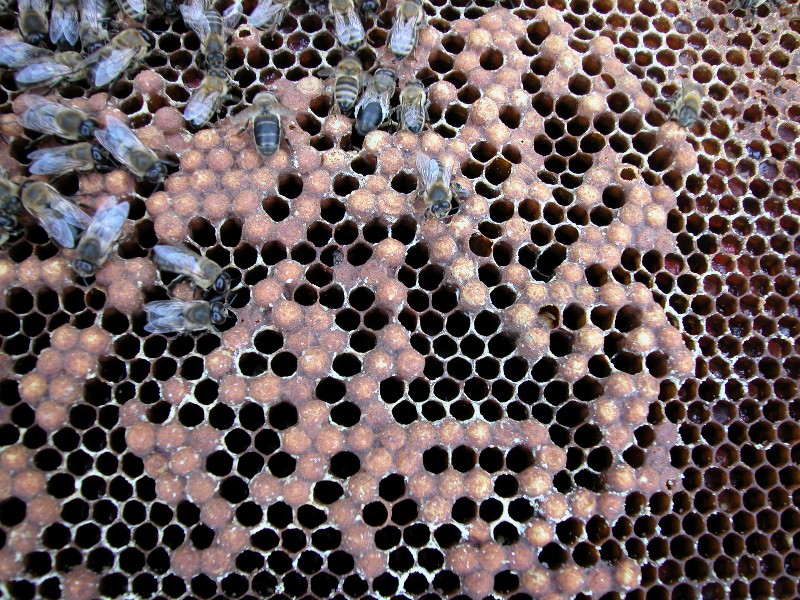Honeybee Diseases - Drone Laying
Abnormal Drone Laying - drone cells are present in virtually all colonies during the summer months. The drone cells are easily recognised by their characteristic domed cappings and are usually found at the edge of the brood nest. Occasionally drone brood can be found in worker cells with or in place of worker brood and may be present as capped cells interspersed with vacant cells or cells at various stages of development.
Queens that are coming to the end of their fertile life or are young and not properly mated will become drone layers. A queen-less colony with no young brood with which to raise a new queen may have workers which will develop functioning ovaries and begin to lay eggs. The eggs of both these cases will be unfertilised and will naturally develop as drones.
Download the Drone Laying Info Sheet to obtain a printable version of Drone Laying information, detection and treatment methods for your records.
Recognition
Image Courtesy The Animal and Plant Health Agency (APHA), © Crown Copyright

Domed Cappings of Drone Brood in Worker Cells. DWV also in evidence.
Brood pattern is irregular and interspersed with normal worker brood and drone brood, not restricted to the edge of the brood nest as normal. Several eggs may be laid in one cell, on the walls as well as at the bottom. The colony temperament may also be adversely affected by this condition. there are two possible causes of this condition:
- A failing or poorly mated queen
- A missing queen and resultant laying workers
Detection
Hive Examination - Examination of brood frames and floor debris is required especially in spring. Bees should be gently shaken from the frames to allow full inspection, abnormalities are then easily spotted.
Monitoring - Vigilance is important with all honeybee diseases and conditions such as Abnormal Drone Laying. Check all apiaries and colonies regularly for health and suspect any colonies that are not thriving where there is no already known reason. Colonies that are not performing well or die out should be examined thoroughly and sealed to prevent robbing and spread of any disease present..
Treatment
Abnormal Drone Laying is not a serious disease, more of a condition existing in the colony. In normal circumstances it is easily recognised during routine hive inspections. If a queen is present it is likely that she is failing through old age or she wasn't fully mated to start with and has run out of sperm. Colonies suffering from Abnormal Drone Laying may need to be re-queened from a reliable source. If there is no queen present then one or two workers will have taken to laying eggs which are infertile, this is a trickier situation to resolve as the colony may not accept a new queen readily. Use a slow release queen cage, or alternatively remove the frames with worker laid eggs and put in a frame of eggs and brood from a known source, it may take a couple of attempts. Prevention is best practice, maintain good apiary housekeeping and bee husbandry:
- Always maintain strong and vigorous colonies that show good hygienic tendencies, re-queen from known healthy colonies.
- Always maintain a high level of hygiene in all your beekeeping practices
- Carry out methodical health inspections on a regular basis, checking for brood disease particularly in spring and autumn.
- Never transfer combs between colonies without checking for brood diseases
- Systematically replace old brood combs in your hives melting down the old comb to maintain clean and healthy brood.
- Never bring colonies or equipment into your apiary without establishing their origin, condition, and disease status.
- Sterilise any secondhand equipment or hive components before introducing them into your apiary
- Discourage drifting and robbing in the apiary
- Suspect stray swarm health until you know otherwise
- Report any incidence of disease or suspicious conditions immediately to your local association
Vectors
There are no vectors identified for this condition. Drone Laying occurs when the queen is absent, or has failed.
Try the Honeybee Diseases Quiz
About the 'My Beekeeping Kit' website.
Contact Iain Dewar for enquiries, suggestions, corrections and contributions for improving the notes. Always welcome!